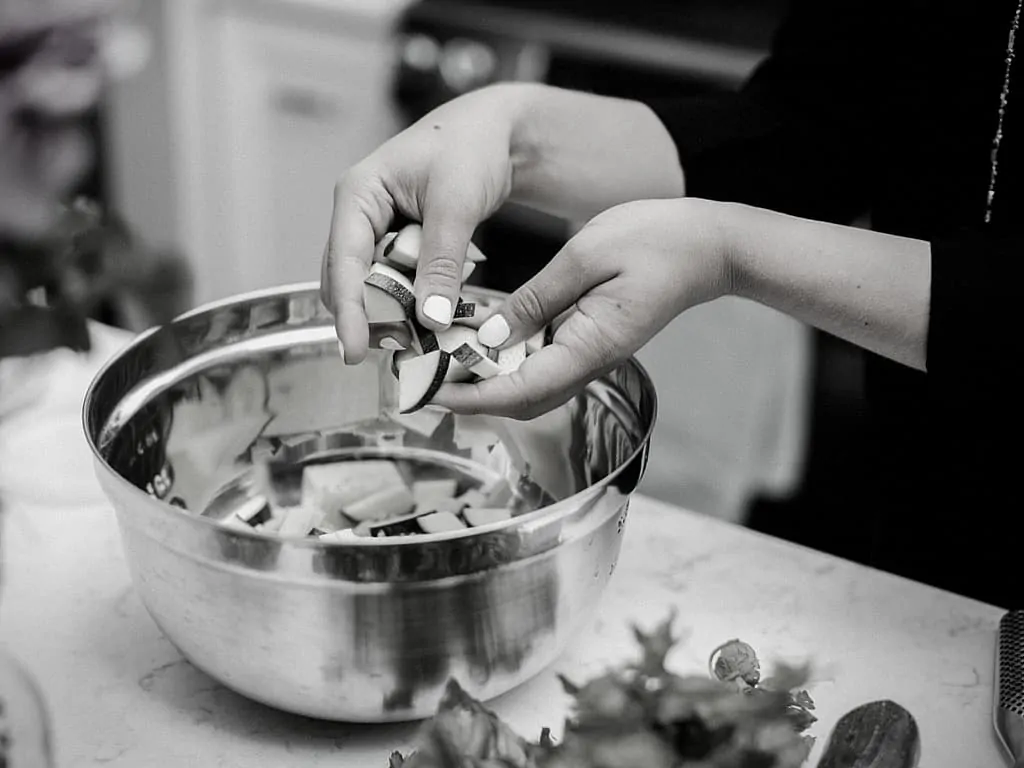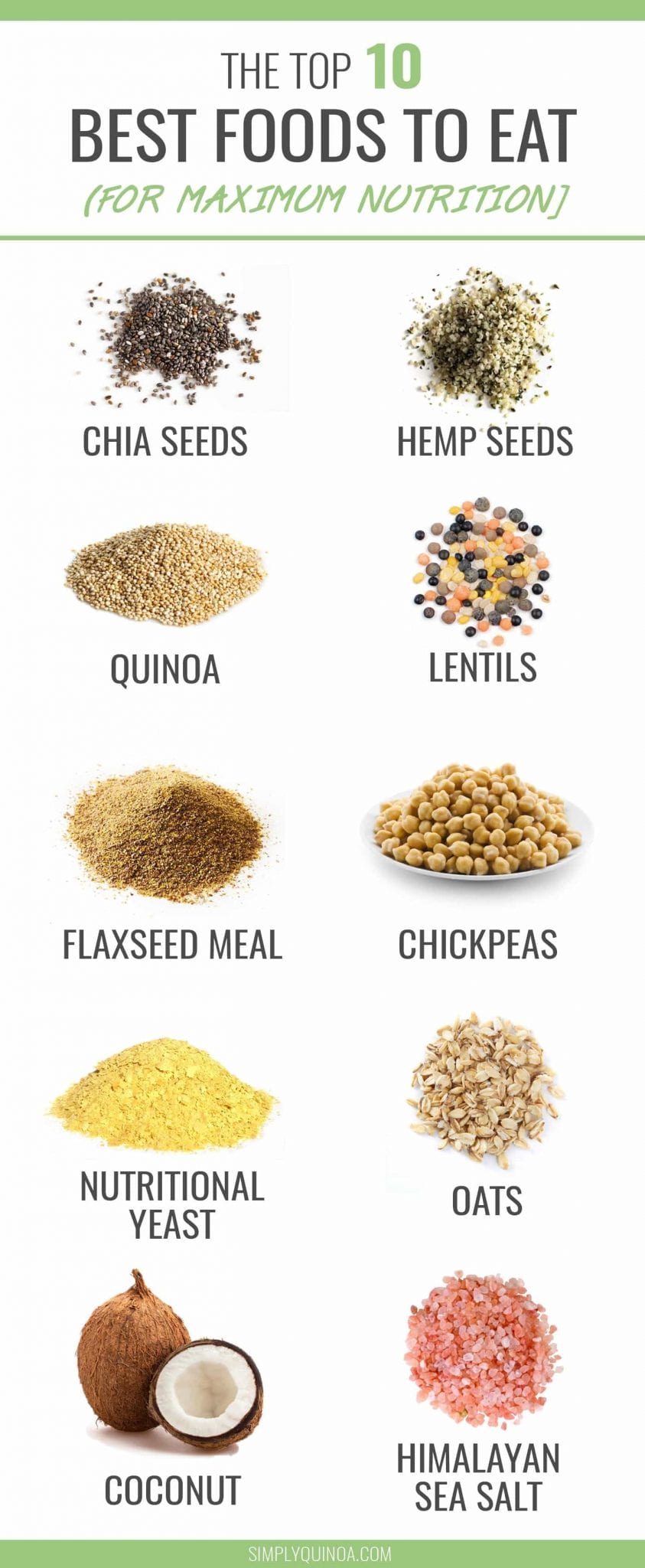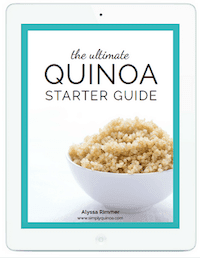Show you the absolute 10 best ingredients to eat to boost the nutrient content of every meal. Add this list of staples for your own pantry!

Did you know that March is national nutrition month?
Kind of a funny thing to consider celebrating since I talk about it all day, every day, but that’s exactly what we’re going to be doing this month. All month long, I’m going to be focusing on bringing you simple, easy, nutritious recipes, all with the goal to help make healthy eating more accessible. It’s taken me a long time to understand that just because we “eat clean” it doesn’t mean that we have to sacrifice anything else in the process – including budget, flavor and time. I want to show you that healthy eating is not only affordable but can also be incredibly flavorful and doesn’t have to take a lot of time.
So this month in celebration of National Nutrition Month, I’m going to be partnering with one of my all-time favorite brands: Bob’s Red Mill. Together, we’re going to provide easy and delicious dishes that focus on maximizing nutrition without any crazy ingredients or cooking techniques. Everything is going to be quick, easy and most importantly tasty!
Before I dive into today's post, first some news! If you're part of the SQ community already and have signed up for the newsletter, then today you'll be getting a free 30-day meal plan with dinner recipes to eat all month long. In addition, I'll also be sending out weekly shopping lists to correspond with the meal plan. There are tons of things to choose from and I've tried to make it as customizable as possible. You can download your meal plan by clicking that link or signing up using the image below ☟☟
Now, to kick things off this month, I wanted to start by sharing a list of my top 10 favorite ingredients you can add to your meals that will increase the nutritional value with minimal effort. Basically, these super-charged ingredients are not only packed full of vitamins and minerals, they’re also versatile and can be used in tons of different ways to boost the nutrient content of what you’re using it in.
1. Chia seeds
One of my favorite superfoods on the planet, chia seeds are such a versatile and amazing little seed. They're not only full of fiber and protein, but they're also rich in omega-3 fatty acids, vitamins, and minerals. In fact, 1 serving of chia seeds at 4.7g of protein, 10g of fiber, 115mg of potassium as well as calcium, phosphorus, and magnesium.
How to use chia seeds:
Chia seeds can be used in pretty much everything – from your morning smoothies, stirred into oatmeal, turned into a decadent pudding, used to thicken a salad dressing or even just used as a garnish, they're a simple ingredient to consume with huge nutritional benefits.
Click here to buy chia seeds >>
2. Hemp Seeds
I just recently talked about my love for hemp seeds, but these are right up there in the realm of chia but have even more protein. Hemp seeds not only taste great, but they have an incredible nutritional profile that is hard to match. In addition to the protein and omega fats, hemp seeds are also high in tons of letter vitamins (like A, Bs, D + E) and minerals like calcium, iron, magnesium, and zinc.
How to use hemp seeds:
Just like chia seeds, hemp seeds are teeny tiny so they can really be used in almost anything. I love adding them to my smoothies (or putting them on top of my smoothie bowls), adding them into pancakes, using them in overnight oats/quinoa and even turning them into pesto.
Click here to buy hemp seeds >>
3. Quinoa
This list would NEVER be complete without quinoa, right? I mean with an entire site dedicated to quinoa, I'm sure you already know how spectacular I think this ingredient is. One of the reasons why I absolutely adore quinoa is the nutritional benefits it brings to my diet. Not only is it high in protein, but it's also a complete protein meaning it has all nine essential amino acids (the amino acids that our body can't produce naturally), as well as being a complex carbohydrate so that it digests slowly and keeps us full.
How to use quinoa:
Well…I'm glad you asked! I have over 500 recipes that use quinoa – yep, 500! – so the possibilities are truly endless. From breakfast, lunch, dinner, dessert, and snacks, quinoa can be the star. And what's even better is that quinoa comes in different forms: the whole seed, flakes, AND flour. (and now crispies too) So truly you can do anything with this wondrous ingredient.
4. Lentils
If I had the choice of only one bean/legume I could eat forever, it might be lentils. (or chickpeas…more on that in a moment). I love that lentils come in all sorts of varieties, but also how nutritious they are. Lentils are easier to digest than other beans, so for folks who are looking for plant-based protein, but tend to feel a little gassy with other beans, lentils are the perfect option. There are 18g of protein in 1 cup of lentils, they are filled with fiber, they're great for heart health, they help balance the pH of your body, stabilize blood sugar AND they help keep you regular. They're definitely one of my favorite pantry superstars.
How to use lentils:
You will find lentils in almost every cuisine around the world – from India, the Middle East, French and beyond. Most commonly found in some sort of soup/stew, you can also find lentils in flour form. I love using lentil in my buddha bowls, on top of my salads for lunch and also in vegan meatloaf!
5. Flaxseed Meal
Another super seed that is packed full of nutrients! Flax is most commonly known for its high levels of omega fats, but it's also high in fiber which is why you sometimes see it being used to help regulate digestion. While flaxseeds themselves are great, it's flaxseed meal that is what I recommend every healthy pantry have. It's easier to digest than whole flaxseeds which often just pass right through your digestive tract, therefore not giving your body any of the amazing benefits. Flax is also high in protein, great for your hair, and can even help with menopausal symptoms.
How to use flaxseed meal:
The easiest way I use flaxseed meal is in my smoothies. Just add a tablespoon in and you're set. You can also use flax in baking – it's great as a vegan egg replacer, but can also be used as a flour. You'll see it in everything from crackers, muffins, pancakes and granola bars. You can also stir in some flax to your morning porridge to help make it more thick and filling.
Click here to buy flaxseed meal >>
6. Chickpeas
Like I said, it's a toss-up between chickpeas and lentils for my favorite legume, and it's because chickpeas not only taste great but they're really great for you. Chickpeas (also knows as garbanzo beans) are a little higher in calories than lentils, but they still have a high amount of protein and fiber making them the perfect plant-based substitute for meat. Additionally, chickpeas are high in vitamins and minerals, especially manganese and folate (or vitamin B6). The only downside of chickpeas is that they can cause gastrointestinal discomfort in some folks (i.e. they might make you toot). If this is the case with you, try spacing out the frequency of consumption to give your body more time to adjust.
How to use chickpeas:
I feel like I should be writing about how not to use chickpeas because there are so many ways. First, there's hummus. Probably one of my absolute favorite snacks in the whole world. And then there are roasted chickpeas which I have been absolutely obsessed with – I use them for a snack, but also as salad or bowl toppings. You can also buy chickpea flour which can be made into a vegan quiche, omelet or pizza!
Click here to buy chickpeas >>
7. Nutritional Yeast
Since I removed dairy from my diet almost 6 years ago, I have come to adore nutritional yeast for its cheesy flavor. What I didn't know about nutritional yeast before I started eating it is that it's a) not the same kind of yeast you use for baking or brewing and b) actually really nutritious. Nutritional yeast is grown on a mixture of cane and beet molasses and is then harvested, dried and packaged. One of the best benefits of nutritional yeast, especially for vegan and vegetarians, is that it's very high in the B-complex vitamins. These are essential vitamins that most plant foods don't contain, so nutritional yeast is the perfect addition. It's also high in protein – 1 serving has 9 grams!
How to use nutritional yeast:
There are so many ways to use it, but my absolute favorite is on top of popcorn. Most commonly you will see nutritional yeast in vegan sauces or used as a garnish to mimic cheese, but you can also use it in baking. I've used it in everything from crackers to pesto and it's become a staple in our house (Matt even likes it too!).
Click here to buy nutritional yeast >>
8. Oats
Oats are probably my second favorite grain behind quinoa (which as you know is technically not a grain, but acts like one). Not only do I adore how versatile they are, but oats are actually quite good for you as well. They're probably most well known for being high in fiber, which makes them a great breakfast food because they're filling and won't spike your blood sugar too much. Oats also contain some protein and trace minerals, but not as much as quinoa 😉
How to use oats:
Most people probably think of oats as being a breakfast food – hot cereal, granola, etc. But oats can also be used for tons of other applications and are an easy way to boost the nutrition of your cooking and baking. You can grind oats into flour and use that for coating and pan-frying things. You can also stir oats into your baked goods to make them more hearty and filling. You can even toss some oats into your morning smoothie to make it extra thick and filling. And of course, there's nothing wrong with making a beautiful bowl of oatmeal in the morning!
Click here to buy oats (certified gluten-free!) >>
9. Coconut
I can't imagine my world without coconut. This might just be one of my all-time favorite superfoods, and I especially love that coconut comes in so many different forms. Each form of coconut has its own unique benefits (and uses), but coconut is most well known for being full of healthy fats. Coconut can also be used to stabilize blood sugar, improve digestion, increase metabolism and even boost immunity.
How to use coconut:
There are a million and one ways to use coconut. Coconut comes in almost every form: milk, water, oil, soft flesh, dried flesh, nectar, vinegar, sugar, and more. And I use almost every single one of them in my own kitchen.
- Milk replaced with coconut milk
- Coconut Water is great for adding to smoothies and used in the base of hot cereals
- Use coconut oil in all forms of baking and cooking
- Soft coconut flesh can be used to make custards and yogurt
- Dried coconut (shredded + flaked) can be used in baking, in granola, cereals, smoothies, salads, etc.
- The coconut nectar can be used to replace liquid sweeteners like honey and maple syrup
- Coconut vinegar can be used in salad dressings
- And course, coconut sugar can be used in all forms of baking and can be substituted 1:1 for regular granulated cane sugar
And the list goes on and on!
Click here to buy coconut products >>
10. Himalayan Sea Salt
I don't use any other form of salt in my kitchen other than pink Himalayan sea salt. As you might already know, traditional table salt (like the kind that comes in those dark blue boxes) is a manufactured form of sodium called sodium chloride. Basically, it's created by heating sodium at super high temperatures which removes all of the good minerals. This can increase blood pressure and is particularly hard on your circulatory and nervous systems. Himalayan sea salt, on the other hand, is pure rose gold.
Just as the name sounds, this amazing salt comes from the Himalayan mountains and is thought to be the purest salt on earth. There are over 80 trace minerals in this salt which all help to balance electrolyte levels, regular water intake between your cells, balance the internal pH of your body, lower blood pressure and remove harmful toxins.
How to use Himalayan sea salt:
You can use this salt in any way that you would traditionally use salt. You can purchase it finely ground and add it to your salt shaker, you can buy it coarsely ground and use it for salt scrubs to exfoliate your skin or you can purchase salt lamps to leave on your desk while you work. I have absolutely loved using this salt in my own cooking and baking and can tell you with complete confidence that I am never going back to table salt again.
Click here to buy pink sea salt >>
What's next?
Now that we've talked about all of best foods to eat to quickly and easily add more nutrition to your diet, now it's time to focus on the food. Over the next four weeks, I have over 15 new recipes coming your way, all of which will incorporate these nutritious ingredients. I also encourage you to hop on the newsletter and get your 30-day meal plan which contains some of my absolute favorite simple recipes. I mean just think…your dinners are planned for an entire month!
New to cooking quinoa? Grab your FREE Quinoa Starter Guide!
Become part of the Simply Quinoa community and your free 30-day meal plan, as well as my in-depth guide to starting your quinoa journey.
This post was sponsored by Bob's Red Mill in celebration of National Nutrition Month. Bob's is my favorite source of healthy, nutritious ingredients! Stay tuned all month long as we share simple and delicious recipes using the amazing products from Bob's. Thank you for supporting the companies I believe in! xo

